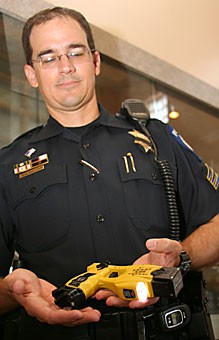The phrase “”Don’t Tase me, bro,”” has gone down in infamy.
With recent coverage of University of Florida police officers Tasering a male student, and the Tasering that occurred during the Sept. 8 UA home football game against Northern Arizona University, use of the non-lethal enforcement device has become more common on university campuses.
Jon Torrez, a biochemistry sophomore, knows all too well.
In attendance at the Jan. 27 basketball game against the University of North Carolina, Torrez was Tasered twice in the back after he did not comply with an officer’s request.
“”I was visibly drunk, and a cop asked me to leave, but I didn’t want to go,”” Torrez said. “”I’m not a big guy, I’m probably about 135 pounds, and at one point there were two officers trying to restrain me. I was already on the ground, but I guess at that point they decided to Taser me.””
In the next few minutes, Torrez said, he was Tasered once more in the back, an action that bloodied his shirt and left him with cuts on his back from where the barbs of the Taser gun implanted in his skin.
With instances such as this occurring on campuses around the country, what are the limits when it comes to Tasering?
At the UA, police officers are trained to use a Taser only when a subject is resisting arrest or threatening an officer, said Sgt. Eugene Mejia, public information officer for the University of Arizona Police Department. Similarly, Tasers are only used on subjects who do not have a weapon, he said, as police officers will pull out their guns on armed subjects.
“”The use of the Taser doesn’t ever replace the use of the firearm, but it replaces the use of physical force,”” Mejia said. “”The Taser minimizes the potential for injury for the officer and the subject.””
UAPD began using Tasers in 2005 and supplies all trained officers with one, Mejia said. The Tasers are used to “”gain control of the subject or to defend oneself,”” he said.
Tasers can also be used on more than one person in order to break up fights or on rabid animals, he said.
According to Taser International, the Scottsdale-based company that sells the devices to UAPD, a Taser uses “”compressed nitrogen to project two small probes … at a speed of 160 feet per second.”” When the probes make contact with the subject, an electrical signal is transmitted, which results in an “”an immediate loss of the person’s neuromuscular control and the ability to perform coordinated action.””
Sgt. Keith Brittain, a UAPD officer and Taser trainer, said a Taser cycle lasts up to five seconds and produces 50,000 volts of energy, only 1,200 of which actually go through the body. The device can be placed directly on the subject or shot from up to 21 feet away, he said.
All officers complete six hours of initial Taser training, and four hours every year there after, Brittain said. During the training, officers must be Tasered themselves.
“”It is painful,”” he said. “”You don’t want to endure it again.””
The Taser is less painful than pepper spray or being hit with a baton because it does not have after-effects, Brittain said.
“”Once the cycle is done, it’s done,”” Brittain said. “”(Pain) doesn’t linger in the body, and the subject is able to walk.””
In Torrez’ case, however, the after-effects of the Taser lasted for the majority of the day.
“”I could feel my heart murmur, like something was off, occasionally during the day,”” Torrez said. “”Also, when I was trying to go to sleep I would feel myself twitch involuntarily.””
Studies have found
I could feel my heart murmur, like something was off, occasionally during the day. Also, when I was trying to go to sleep I would feel myself twitch involuntarily.
Jon Torrez,
UA Taser victim
that Tasers can cause health complications, such as heart attacks, in some people.
“”Taser shock can affect the heart, although this is very rare,”” said Dr. Peter Ott, director of the electrophysiology laboratory and arrhythmia services at the UA Health Sciences Center.
Animal data indicate that the energy needed to affect the heart rhythm “”is significantly higher than the output of the Taser gun,”” Ott said. “”Reports testing the Taser gun on healthy [human] volunteers, showed no impact on heart rhythm.””
Some studies show that victims of a Taser shock have died of abnormal heart rhythm, but that could be affected by drug use, underlying heart disease, extreme agitation or the use of implantable pacemakers or defibrillators, Ott said.
“”From the available data, Taser guns are safe, though nothing is perfect,”” Ott said. “”One study showed that the mortality rate in immobilizing criminals is extremely low and vastly improved compared to using firearms.””
Despite all the recent media hype, Mejia said UAPD has used the Taser only 11 times since 2005, and only two of those involved UA students, one of whom was Torrez.
Sara Pat Badgley, a family and consumer sciences junior and former wire editor of the Arizona Daily Wildcat, was at the Jan. 27 UNC game when she saw Torrez get Tasered.
“”I heard a lot of commotion and saw (him) fall down, which was the result of the Taser,”” Badgley said. “”I had two thoughts go through my head. One, I didn’t notice any commotion until it happened, so he wasn’t a direct threat, and I didn’t know why they went to such extreme measures. But with as much attention as it picked up, he must have been doing something that warranted that kind of a response.””
When it comes to deciding whether or not to use a Taser gun, Mejia said the actions of the person involved are a contributing factor.
“”We don’t go around looking for opportunities to use it,”” he said.
-Kelly Lewis contributed to this report
BY THE NUMBERS
8,000: law-enforcement agencies nationwide use “”conducted energy devices””
22: percent of law enforcement agencies allow Taser use for verbally resisting police officers
0:regulations exist on the use or safety of Tasers
-statistics courtesy of the ACLU of Oregon
Ore. student Tasered, dies Nicholas Ryan Hanson, a 24-year-old Southern Oregon University student, died Jan. 22, 2006, after Ashland, Ore., police officers Tasered him. Hanson was reportedly trying to take his own life before officers intervened. When he became “”combative and violent”” with the officers, Hanson was Tasered. His vital signs began to fail on the way to Rogue Valley Medical Center in Medford, Ore., where he was to be seen at the center’s mental health facility. Hanson was pronounced dead after a 30-minute resuscitation attempt. While his death was ruled to be due to an overdose from prescription drugs, there is still doubt to whether the Taser contributed to his death. A recent study said, in Hanson’s weakened state, he did not need to be subdued by Taser.
-information from the Ashland Daily tidings newspaper and a recent ACLU of Oregon study









